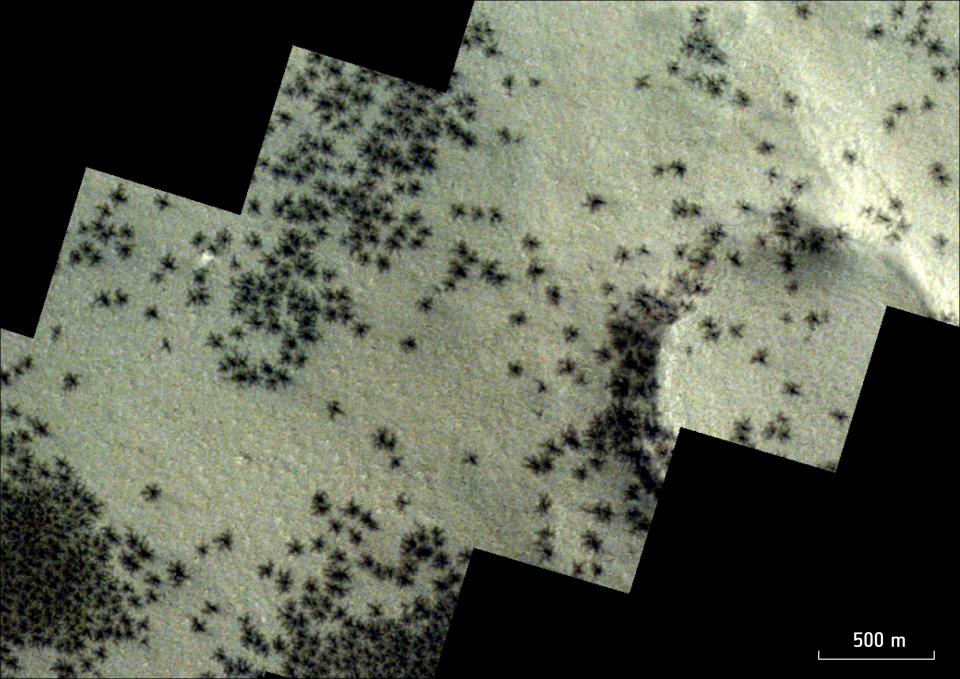An orbiter captured images of 'spiders' on Mars in Inca City. But what is it, really?
One look at recent images released by the European Space Agency may cause you to wonder if spiders are on the cusp of bursting forth onto the Martian surface.
But arachnophobes have nothing to fear, even if the Mars orbiter images appear to suggest that the Red Planet has succumbed to an infestation of creepy crawlies. Rather, a strange chemical reaction recently captured by European Space Agency probes is to blame for the spider-like feature spotted at a formation known as Inca City in Mars' southern polar region.
As the ESA explained, the images comprised of data gathered Feb. 27 by the Mars Express orbiter show clustered dots that formed due to seasonal eruptions of carbon dioxide gas.
It's just the latest instance in which this distinctive phenomenon has been documented. ESA's ExoMars Trace Gas Orbiter has also captured visual evidence of the spidering effect, as have NASA spacecrafts.
Here's what to know about it.
What to know about SLIM: Japan's lunar lander still powers away 3 months later
What are the 'spider' formations really?

The features known as "spiders" form when the weather starts to warm during the Martian springtime.
As the sunshine falls on layers of carbon dioxide deposited over the dark winter months, the ice begins to melt and the warmth causes the lowest layers of ice to turn to gas. The carbon dioxide gas warms and builds up before eventually breaking through slabs of overlying ice, dragging dark dust with it to the surface that shatters through like a geyser.
When the dust settles back down, it etches patterns into the surface and beneath the ice that manifest as dark blotches resembling the spindly legs and bodies of spiders.
The process is unlike anything seen on Earth.
ESA's Mars Express orbiter captures latest sign of 'spiders'
The latest images of the formations, which are channels of gas measuring 0.03 to 0.6 miles across, were most recently captured by ESA's Mars Express orbiter, which arrived at the planet in 2003.
The formation of dark spots indicating the presence of "spiders" was spotted in Inca City, a region nicknamed for its resemblance to the Inca Ruins of Earth.

Another of ESA’s Mars explorers, the ExoMars Trace Gas Orbiter (TGO), has previously imaged the spiders’ tendril-like patterns especially clearly in 2020 in a nearby region. While the Mars Express view shows the dark spots on the surface, the TGO perspective captured the web-like channels carved into the ice below.
NASA's Mars Reconnaissance Orbiter also captured images in 2018 showing the "spiders" beginning to emerge from the landscape.
In the Mars Express image, the dark spots can be seen creeping across the towering hills and expansive plateaus of the mysterious Inca City discovered in 1972 by NASA’s Mariner 9 probe. While scientists aren't exactly sure how the ridges and walls formations of Inca City came to be, it's theorized to be the remnants of sand dunes turned to stone.
In 2002, NASA's Mars Orbiter revealed that Inca City is part of a large circle approximately 53 miles wide – suggesting the formation is the result of a space rock crashing into the surface and creating a crater. Faults that rippled through the surrounding plain could have filled with rising lava that has since worn away, revealing a formation resembling ancient ruins.
Eric Lagatta covers breaking and trending news for USA TODAY. Reach him at [email protected]
This article originally appeared on USA TODAY: 'Spiders' spotted on surface of Mars: Here's what they really are
